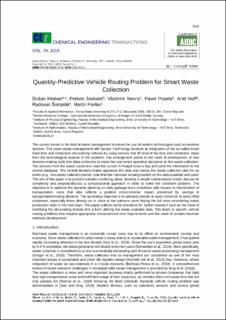| dc.contributor.author | Hrabec, Dušan | |
| dc.contributor.author | Senland, Preben | |
| dc.contributor.author | Nevrly, Vlastimir | |
| dc.contributor.author | Popela, Pavel | |
| dc.contributor.author | Hoff, Arild | |
| dc.contributor.author | Šomplák, Radovan | |
| dc.contributor.author | Pavlas, Martin | |
| dc.date.accessioned | 2023-10-06T12:45:23Z | |
| dc.date.available | 2023-10-06T12:45:23Z | |
| dc.date.created | 2019-10-23T13:17:39Z | |
| dc.date.issued | 2019 | |
| dc.identifier.citation | Chemical Engineering Transactions. 2019, 76, 1249-1254. | en_US |
| dc.identifier.issn | 1974-9791 | |
| dc.identifier.uri | https://hdl.handle.net/11250/3094981 | |
| dc.description.abstract | The current trends in the field of waste management involves the use of modern technologies such as wireless sensors. The smart waste management with Sensor Technology involves an integration of the so-called smart trash bins and containers into existing network by using sensors that fill level of the bins and containers. Apart from the technological aspects of the problem, this arrangement points to the need of development of new decision-making tools that allow collectors to make fast and smart operative decisions on the waste collection. The sensors from the waste containers read the current fill-height once a day and send the information to the central database. The central decision-maker appraises the data and makes the waste collection plan for an entire (e.g., one week) collection period; note that this improves existing models on the data available and used. The aim of this paper is to present complex modelling ideas, develop a simple mathematical model, discuss its complexity and propose/discuss a computational approach in order to solve the collection problem. The objective is to optimize the dynamic planning on daily garbage-truck schedules with respect to minimization of transportation costs that also reflects a positive environmental impact presented by savings in transportation/routing distance. The secondary objective is to optimally decide on early collection of partly-filled containers, especially those directly on or close to the optimum route linking the full ones considering waste production rates in the next days. The paper outlines some directions for further research such as the need of modifying the old-existing models into a form utilizing the newly available data. This leads to specific vehicle routing problems that request appropriate computational time requirements and the need of suitable heuristic methods development. | en_US |
| dc.language.iso | eng | en_US |
| dc.relation.uri | https://www.aidic.it/cet/19/76/209.pdf | |
| dc.rights | Navngivelse 4.0 Internasjonal | * |
| dc.rights.uri | http://creativecommons.org/licenses/by/4.0/deed.no | * |
| dc.title | Quantity-predictive vehicle routing problem for smart waste collection | en_US |
| dc.type | Peer reviewed | en_US |
| dc.type | Journal article | en_US |
| dc.description.version | publishedVersion | en_US |
| dc.source.pagenumber | 1249-1254 | en_US |
| dc.source.volume | 76 | en_US |
| dc.source.journal | Chemical Engineering Transactions | en_US |
| dc.identifier.doi | 10.3303/CET1976209 | |
| dc.identifier.cristin | 1739851 | |
| dc.relation.project | Norges forskningsråd: 263031 | en_US |
| cristin.ispublished | true | |
| cristin.fulltext | original | |
| cristin.qualitycode | 1 | |

